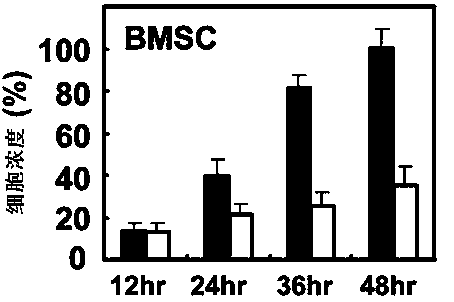Stem cell medium and application thereof
A culture medium and stem cell technology, applied in the field of stem cell culture, can solve the problems of difficult stem cell culture and reduced differentiation potential.
- Summary
- Abstract
- Description
- Claims
- Application Information
AI Technical Summary
Problems solved by technology
Method used
Image
Examples
Embodiment 1
[0196] Example 1: Experiments on Acceleration of Stem Cell Proliferation
[0197] 1. Test medium: conventional medium components: DMEM / F12 basic medium, 10% fetal bovine serum (FBS); the medium of the present invention.
[0198] 2. Source of cultured stem cells: human stem cells (ADSC, BMSC, UMBSC) derived from fat, bone marrow and umbilical cord respectively.
[0199] 3. In vitro cell culture experiments. The cell seeding density was controlled between 10-20%, and culture medium was added after seeding (37°C, 5% CO2). Cell density was measured every 12 hours by the MTT method. Figure 1-3 As the experimental results of this example, it can be seen from the figure that the stem cells (solid column) cultured in the medium of the present invention show a faster expansion rate than the cells (hollow column) cultured in the conventional medium , [data are the mean ± SEM of three independent experiments (P <0.0001)]. Therefore, compared with the conventional culture medium, the...
Embodiment 2
[0200] Example 2: Influence experiment on the potential analysis of proliferating mesenchymal stem cells divided into chondrogenic cells in vitro
[0201] 1. Test medium: conventional medium components: DMEM / F12 basic medium, 10% fetal bovine serum (FBS); the medium of the present invention.
[0202] 2. Source of cultured stem cells: human stem cells (ADSC, BMSC, UMBSC) derived from fat, bone marrow and umbilical cord respectively.
[0203]3. In vitro cell culture experiments. The chondrogenic differentiation experiments of human stem cells (ADSC, BMSC, UMBSC) derived from fat, bone marrow, and umbilical cord tissues and organs after expansion were determined according to the method described in the literature (Nat Protoc 2010; 5: 1294–1311; Biomaterials. 2004 Jul;25(16):3211-22; Tissue Eng Part A. 2009 Feb;15(2):231-41). When the stem cells grow to a suitable density (cell density 20-80%), add chondrogenic induction medium (DMEM / F12 medium with 1% FBS, 10 mg / L TGF, 50 nM vi...
Embodiment 3
[0204] Embodiment 3: Effect experiment on the potential analysis of adipogenic cells
[0205] 1. Test medium: conventional medium components: DMEM / F12 basic medium, 10% fetal bovine serum (FBS); the medium of the present invention.
[0206] 2. Source of cultured stem cells: human stem cells (ADSC, BMSC, UMBSC) derived from fat, bone marrow and umbilical cord respectively.
[0207] 3. In vitro cell culture experiments. In order to further examine the influence of stem cells on their differentiation potential after being amplified by the medium described in the present invention for 8 generations, we measured the The method described in the literature measured the differentiation experiment of adipocytes after the expansion of human stem cells (ADSC, BMSC, UMBSC) derived from fat, bone marrow and umbilical cord (Methods in Molecular Biology, 2011, Volume 702, Part 3 , 193-200; Methods. Volume 45, Issue 2, June 2008, Pages 115–120; Cytotherapy. 2003, Vol.5, No.5, Pages 362-369)...
PUM
 Login to View More
Login to View More Abstract
Description
Claims
Application Information
 Login to View More
Login to View More - R&D
- Intellectual Property
- Life Sciences
- Materials
- Tech Scout
- Unparalleled Data Quality
- Higher Quality Content
- 60% Fewer Hallucinations
Browse by: Latest US Patents, China's latest patents, Technical Efficacy Thesaurus, Application Domain, Technology Topic, Popular Technical Reports.
© 2025 PatSnap. All rights reserved.Legal|Privacy policy|Modern Slavery Act Transparency Statement|Sitemap|About US| Contact US: help@patsnap.com



